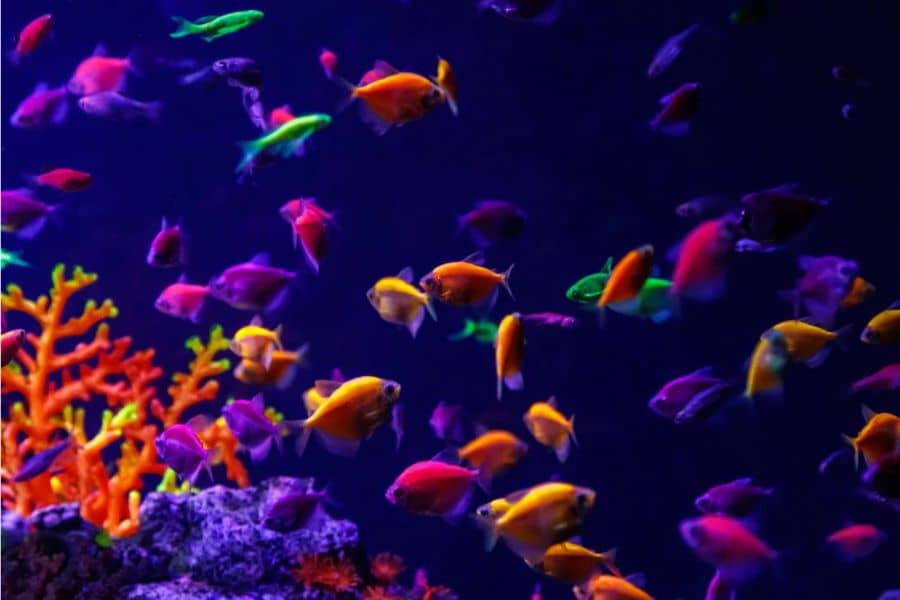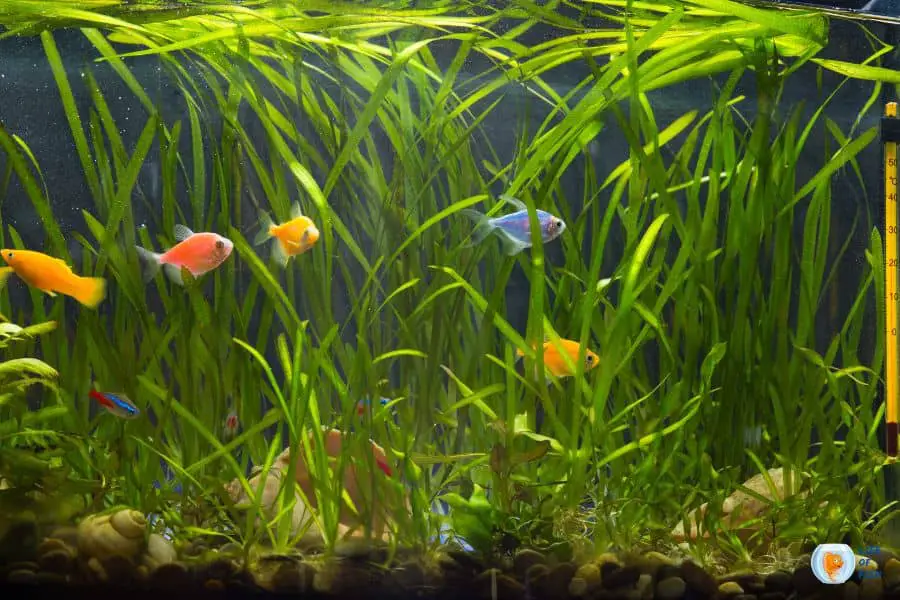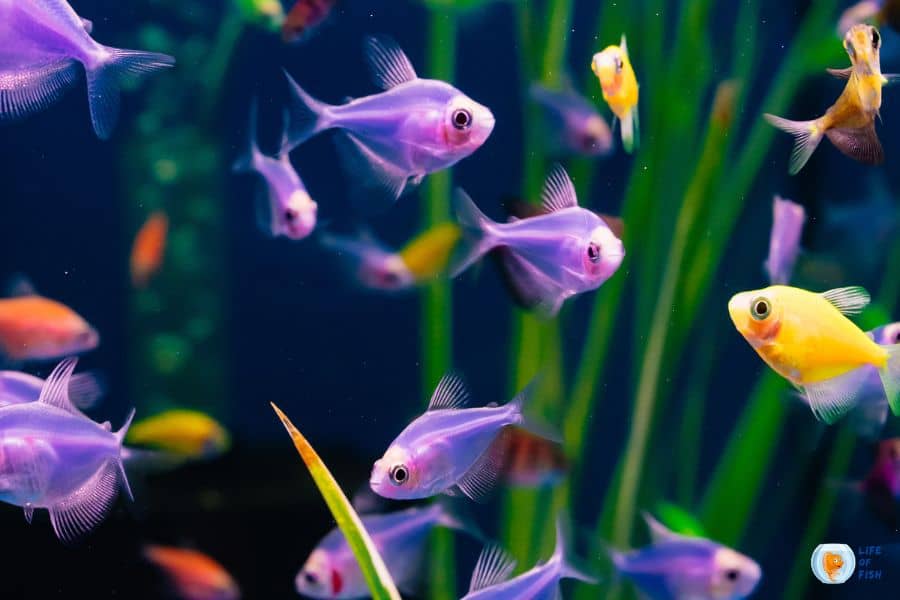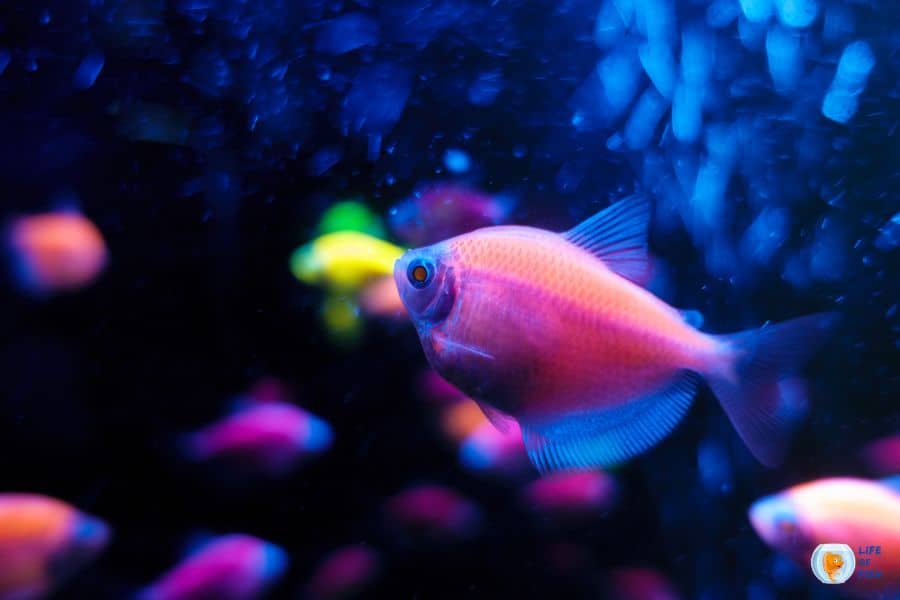This is a detailed article about How Long Do Glofish Live, their diseases, and how we can care for them to ensure they live an extended happy life. Further, we will discuss whether they can reproduce and will provide some tips to make your glofish live longer.

Anyone who is fascinated by glowing marine creatures like jellyfish and corals loves Glofish. These freshwater fish were genetically engineered to contain a fluorescent protein gene derived from these marine organisms. As a result, Glofish emits light and appears to glow in various colors under a special blue light. People love to buy them as pets because of their beautiful appearance.
But the question is, how long do Glofish live? On average, Glofish has a lifespan of 2-3 years. However, some Glofish have been known to live up to 7 years with proper care. Like all pets, the key to prolonging a Glofish’s life is to provide them with good care and a healthy environment. This includes a clean and well-filtered tank, regular water changes, and a healthy diet.
What is Glofish?
Jump To
- 1 What is Glofish?
- 2 Do Glofish Have A Shorter Lifespan?
- 3 How Long Do Glofish Live?
- 4 Is Glofish Hard To Keep Alive?
- 5 Which Glofish Live The Longest?
- 6 How Long Can Glofish Go Without Eating?
- 7 How To Make Glofish Live Longer?
- 8 Can Glofish Reproduce?
- 9 Facts About Glofish Reproduction
- 10 How To Breed Glofish?
- 11 Glofish Diseases
- 12 Conclusion
Glow fish are “manipulated” and “modified” fish that was designed solely to detect how environmental pollution affects the tissue. The idea was that the fish would become fluorescent when pollution was discovered in the water. To reach this goal, first, the fish must be fluorescing in the first place. For this, scientists introduced natural fluorescence genes such as jellyfish protein or sea coral into zebra danio embryos.
Each kind of protein resulted in a distinct fluorescent color for the fish. The distinct look of these newly created species sparked the public’s interest, and they were soon available in pet stores under the brand “Glofish.” These fish are patented, and their fluorescent genes cannot be transferred to other species.
Do Glofish Have A Shorter Lifespan?
Some may think that Glofish have a shorter lifespan due to their genetic modification, but that is not the case. In fact, Glofish often have a lifespan similar to that of their unmodified zebrafish counterparts. The typical lifespan of a Glofish is anywhere from 2-7 years, depending on the Glofish species.

How Long Do Glofish Live?
As we mentioned above, Glofish lifespan differs depending on the species. As of 2022, there are 6 Glofish species available on the market:
- Glofish Barbs
- Glofish Bettas
- Glofish Danios
- Glofish Tetras
- Glofish Long Fin Tetras
- Glofish Sharks
Among these species, Glofish sharks have the longest lifespan of about 4 to 7 years with proper care. Glofish Danios have the shortest lifespan of about 2 to 3 years.
Is Glofish Hard To Keep Alive?
With the proper care, Glofish is not hard to keep alive. However, they are not recommended for beginner fishkeepers since they require a bit more care than other fish species. We advise you to do your research before getting Glofish and be prepared to provide them with the best care possible.
Which Glofish Live The Longest?
As we mentioned before, Glofish Sharks have the longest lifespan of up to 7 years. Glofish Danios have the shortest lifespan of around 2 to 3 years. However, with proper care, all Glofish species can have a lifespan similar to that of their unmodified counterparts.
How Long Can Glofish Go Without Eating?
Glofish can go without food for about a week without any adverse effects. The maximum time a Glofish can go without food is two weeks. However, we do not encourage testing this limit because it may be detrimental to your fish. If you are going on vacation or will be out of town for an extended period of time, we recommend that you either hire someone to feed your fish or get an automatic fish feeder.

How To Make Glofish Live Longer?
You can help your Glofish have a long and healthy life by doing the following:
Keep the tank clean.
Glofish are also fish. The only difference between them is that they glow. Otherwise, they also have the same needs as any other fish species. This means that they need a clean and well-maintained aquarium to live a long and healthy life. A clean tank provides a healthy environment for your fish and helps prevent the spread of diseases. We advise you do a partial water change of 20-30% every week and a complete tank cleaning every month.
Provide a balanced diet
A healthy and balanced diet is vital for all animals, including fish. Glofish are no exception. We recommend that you feed your Glofish a variety of foods to ensure they get all the nutrients they need. Some of the best food for Glofish include:
- pellets
- flakes
- bloodworms
- brine shrimp
- daphnia
- cyclops
You can either buy live or frozen foods for your Glofish. We recommend that you buy live foods since they are more nutritious and provide more benefits for your fish.
Avoid overfeeding
One of the most common mistakes made by fishkeepers is overfeeding their fish. Overfeeding pollutes the water and can lead to health problems for your fish. We recommend that you only feed your Glofish as much as they can eat in a few minutes.
Provide hiding places
Hiding places are important for all fish, especially Glofish. Glofish are naturally shy and timid, so they need a place to hide when they feel scared or threatened. We recommend that you provide hiding places in your tank for your Glofish. Some of the best hiding places for Glofish include:
- plants
- rocks
- caves
- huts
If you provide hiding places for your Glofish, they will feel more secure and be less stressed. This will lead to a longer and healthier life.
Do not overhandle
Overhandling is one of the most common causes of stress in fish. When stressed, fish are more susceptible to diseases and have a shorter lifespan. We recommend that you only handle your Glofish when it is necessary. If you must handle your fish, be sure to do so gently and carefully.
Ensure a disease-free environment
One of the prevailing causes of death in fish is disease. The majority of illnesses are transmitted through contact with other fish. This is why it is crucial to keep your fish in a clean and disease-free habitat. We recommend that you quarantine new fish before adding them to your tank. This will aid in the prevention of disease spread. You should also regularly check your fish for signs of disease. Some of the most prevalent signs of disease in fish include:
- loss of appetite
- fin loss
- weight loss
- bulging eyes
- skin lesions
- listlessness
- death
If you notice any of these signs, we recommend that you consult a veterinarian as soon as possible.
Can Glofish Reproduce?
Reproducing is a part of any fish’s life cycle, and Glofish has no exception. Although genetically modified, Glofish can still reproduce and produce offspring that inherit their genes and characteristics.
Legal Status Of Glofish Reproducing
Although glofish can reproduce, you can not simply breed them and sell them off for money. Since these fish are patented and owned by Yorktown Technologies LLC, only they have the legal rights to produce and sell glofish. It is illegal to breed or sell glofish without prior consent from Yorktown Technologies LLC.
If you wish to sell glofish, you’ll first have to sign a contract with Yorktown Technologies LLC that will give you the legal rights to do so. However, you are free to breed these fish for your own use. In short,
- You can’t sell, barter or give away any glofish you bred at home.
- You can’t release these home-bred fish into the wild.
So, if you keep these fish as pets, you can breed them, but you’ll have to keep the fry (baby fish).

Facts About Glofish Reproduction
Now that we know that glofish can breed let’s look at some interesting facts about their reproduction.
- Glofish are easy to breed, like their counterparts.
- GloFish comes in six different hues, and if you breed a green fish with a purple one, the offspring will be green or purple. The colors do not mix when they breed.
- The color of the offspring won’t go away as they grow up. So, if you breed a green glofish, the fry (baby fish) will also be green.
- Glofish are livebearers, which means they give birth to live fry (baby fish).
- The gestation period of glofish is around 28 days.
- A female glofish can give birth to anywhere between 20 to 40 fry (baby fish) at a time.
- The fry (baby fish) of glofish is extremely small, measuring only about 6 mm in length. Because of this, you may not be able to see their colors when they are born.
- It will take around 4 to 6 weeks for the fry (baby fish) to develop its colors.
- The fry (baby fish) of glofish are born fully developed and can fend for themselves soon after birth.
How To Breed Glofish?
Breeding glofish is just like breeding their counterparts. Glofish also inherit their characteristics and behavior from their unmodified counterparts. So, if you want to breed glofish, you’ll have to follow the same steps that you would for any other fish. You would have to set up a breeding tank for your glofish. The breeding tank should be at least 10 gallons in size.
- The breeding tank should have a sponge filter and a heating element to maintain the water temperature.
- You should also add several live aquarium plants to the breeding tank to provide cover for the fry (young fish).
- You should dimly light the breeding tank to help the glofish feel comfortable.
- You should also add a gravel layer to the breeding tank.
- The water in the breeding tank should be well-oxygenated.
- The ideal water temperature for breeding glofish is around 75-80 degrees Fahrenheit.
- You should also make sure that the breeding tank has a tight-fitting lid to prevent the fry (baby fish) from escaping.
- You should also remove any other fish from the breeding tank.
When the breeding tank is set up, you can then add a pair of glofish to the tank.
- The male and female glofish will then start to mate.
- After a few weeks, the female glofish will start to show signs of pregnancy.
- The female glofish will then give birth to live fry (baby fish).
- Glofish Bettas, on the other hand, will lay eggs which will then hatch into fry (baby fish).
- The fry (baby fish) of glofish is extremely small and can be difficult to see.
- You can use a small net to scoop out the fry (baby fish) from the breeding tank.
- You should then transfer the fry (baby fish) to a separate tank.
- You should keep the fry (baby fish) in a separate tank until they are large enough to be added to the main tank.
- The fry (baby fish) of glofish will start to develop their colors after 4 to 6 weeks.
- You can then add the fry (baby fish) to the main tank.
Glofish Diseases
While Glofish can live long and healthy lives, there are a few things that can shorten their lifespan. The disease is one of the most prevalent causes of death in Glofish. Glofish are, like their unmodified counterparts, prone to common fish ailments. Some of the diseases that glofish are susceptible to include:
Ich
- This is a common fish disease that is caused by a parasite. Ick symptoms include white patches on the fish’s body.
- The affected fish will also scratch itself against objects in the tank.
- You can treat ich with a number of different medications.
- You can also raise the temperature to around 86 degrees Fahrenheit to kill the parasite.
- You should also do a water change and clean the tank to remove the parasite from the tank.
Velvet Disease
- This is a common fish disease that is caused by a parasite. The symptoms of velvet disease include gold or brown dust on the fish’s body.
- The affected fish will also scratch itself against objects in the tank.
- You can treat velvet disease with a number of different medications.
- You can also raise the temperature to quicken the parasite’s life cycle.
- Further, covering the aquarium to leave it in complete darkness for several days also helps.
- You should also do a water change and clean the tank to remove the parasite from the tank.
Fin Rot and Tail Rot
- Fin rot and tail rot are common fish diseases that are caused by bacteria. The symptoms of these diseases include frayed or ragged fins.
- The affected fish will also have red or inflamed skin.
- You can treat fin and tail rot with several different medications.
- You should also do a water change and clean the tank to remove the bacteria from the tank.
Columnaris
- Columnaris is a common fish disease that is caused by bacteria. The symptoms of columnaris include white patches on the body of the fish.
- The affected fish will also have ragged fins.
- Columnaris can be treated with antibacterial medications.
- You should also do a water change and clean the tank to remove the bacteria from the tank.
Dropsy
- Dropsy is a common fish disease that is caused by bacteria. The symptoms of dropsy include bloating and scales that stand away from the body.
- The affected fish will also have pinecone-like scales
- You can treat dropsy with antibiotics.
- You should also do a water change and clean the tank to remove the bacteria from the tank.
Conclusion
Glofish do not have a shorter lifespan than unmodified counterparts, despite the prevalent notion. In reality, Glofish can live long and healthy lives with the proper care. However, like all fish, they are susceptible to diseases that can shorten their lifespan. The most common cause of death in Glofish is a disease. Thus, it is important to know the signs and symptoms of common fish diseases and treat them promptly. With the proper care, Glofish can provide years of enjoyment.
Read Next : How Often Do You Feed Glofish? (Answer Is Here)
